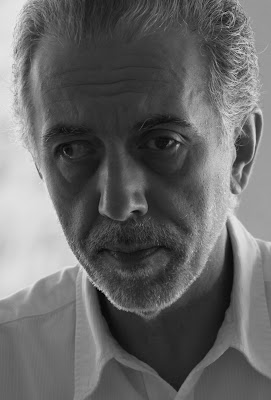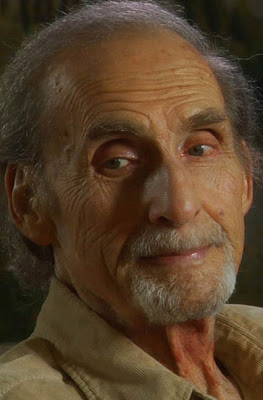Further, both film are set in France against a backdrop of war: Renoir has WWI going on at a discreet distance; The Artist and the Model uses WWII for some suspense and philosophy, particularly in a scene in which a German officer and friend of the sculptor pays an unexpected visit just as a partisan (newcomer Martin Gamet, above) is in hiding on the premises.
One big difference -- and a good one -- between the movies is that Trueba chose to film his in black-and-white. The look of the film is marvelous; it takes us immediately back, not so much to the place itself -- France in the early 1940s or late 30s -- but to all the other movies we've seen about this location and time.
This also works well due to the kind of art each of our men produces: Renoir was involved in color and light, while our guy, called Marc Cros (and played with enormous subtlety and discretion by the great Jean Rochefort, above), sculpts in clay which is eventually cast into white marble. We don't miss the color in his work; instead the lovely b/w cinematography (from first-time credited cinematographer Daniel Vilar) creates a hugely nostalgic time and place.
Similar, too, in these films is the manner in which the first-time model learns her trade and the relationship that grows between artist and model. Trueba's film, in fact, takes this into slightly more intimate territory than did Bourdos'. The model here is played by Aida Folch, (shown above and below) a young Catalonian actress not yet 30 who has already made 30 film and TV appearances. She's a terrific choice -- able to bring a quiet ferocity and strength to her role, even as she learns and grows. Plus -- she's got a dynamite body. What artist wouldn't want to use her?
As the wife and model-procurer, Claudia Cardinale (below, left, whom I must admit I did not recognize in this role, so much has she changed from her earlier glamour days) is properly loving and helpful, with the great Spanish character actress Chuz Lampreave (below, right), doing a nice turn as the family's acerbic-but-kind housekeeper.
Though this film was nominated last year for 13 Goya awards, it won none, and I can rather guess why. Trueba, a good enough filmmaker, never comes close to greatness. His work varies from OK (Belle Epoque) to very good Chico & Rita to much-less-than (The Dancer and the Thief), and he does like to underline things.
Sometimes this works to surprisingly wonderful effect, as in the scene in which Rochefort tutors Folch on the delights of a Rembrandt sketch. This becomes a sublime 5 to 10-minute art class in which we and the model learn so much and, thanks to the actors and the writing, is beautifully conceived and performed.
Yet another scene that comes out of nowhere fares not nearly so well. Taking place between a group of schoolkids and a local priest, it is meant, I guess, to underline the paltry place of religion in society, and show us the difficulties of dealing with the human body unclothed -- with both of which I fully agree. But the scene is so ham-fisted and unnecessary that the viewer may wonder why it has to be there at all.
On balance, I would still have to recommend The Artist and the Model -- for its subject, visual beauty, performances and a particularly graceful flow. (It is slow-moving, however, so get ready to let your eyes range across the lovely panorama.) The movie, from Cohen Media Group and running 105 minutes, opens this Friday, August 2, in New York City at the Lincoln Plaza Cinema and in Los Angeles at The Landmark. Futher playdates nationwide will follow, as soon as Cohen gets them posted on its site....
Note: I was not able to do my planned Q&A with this filmmaker,
but there is a very good one you can read by
Anne-Katrin Titze at Eye For Film.
Just click here.
















a.jpg)

.jpg)
.jpg)
.jpg)
.jpg)











.jpg)
.jpg)
-a.jpg)

.jpg)













